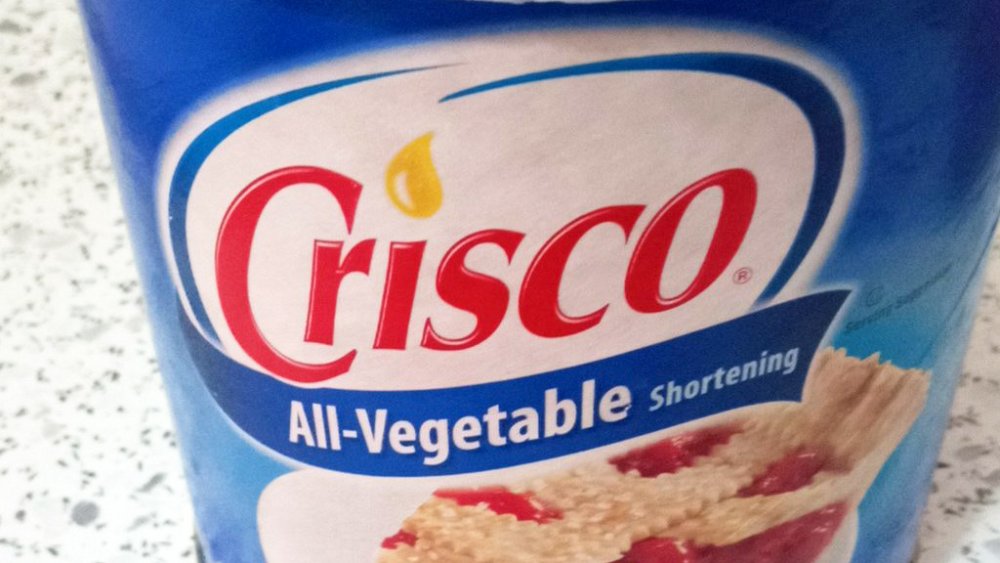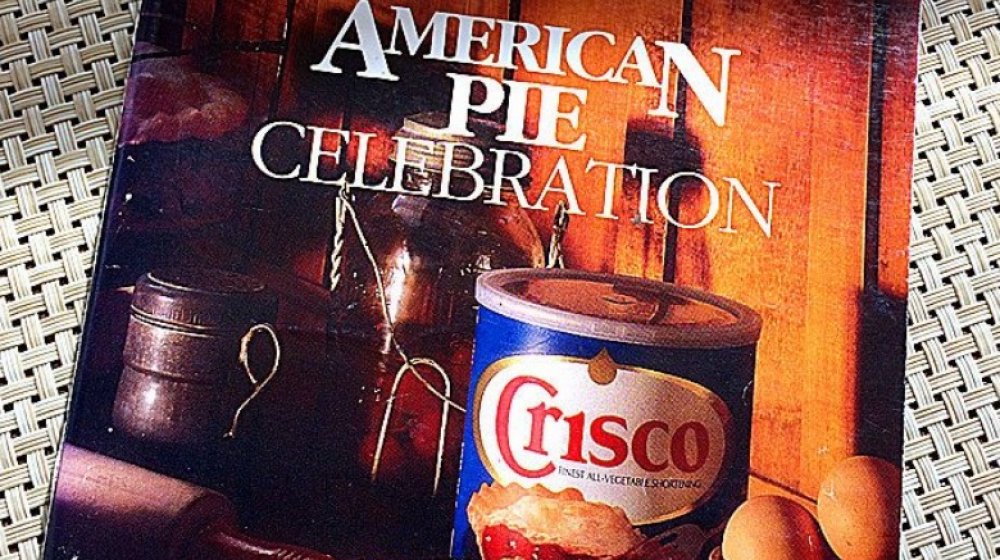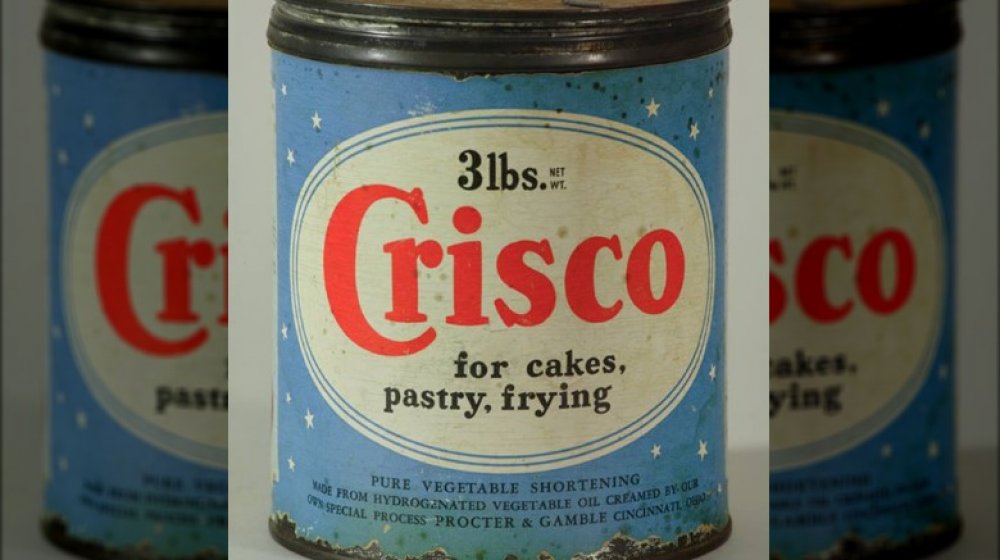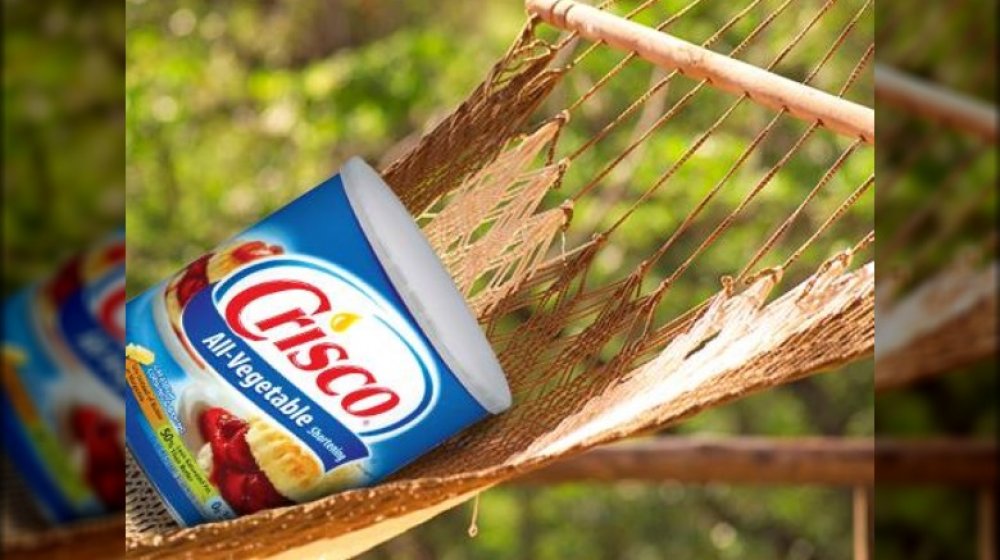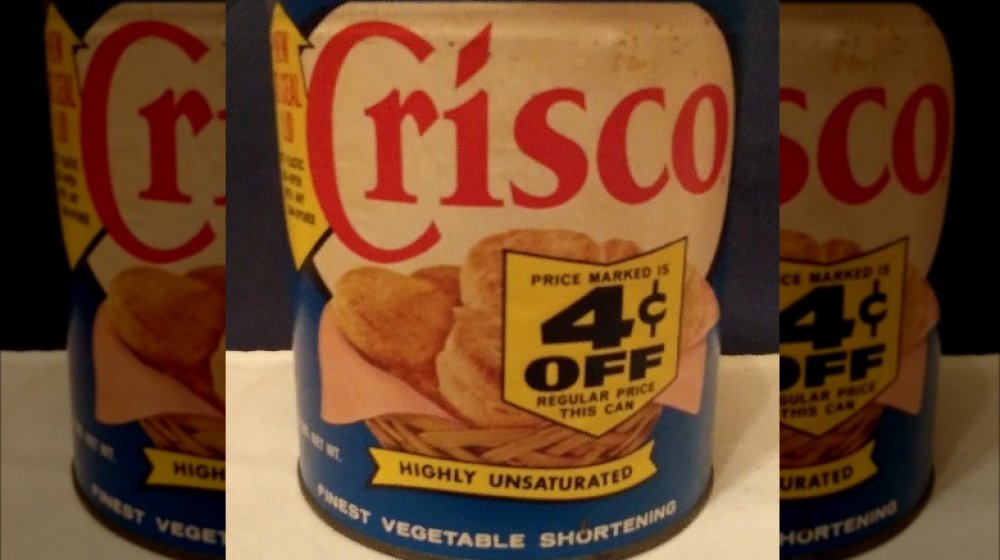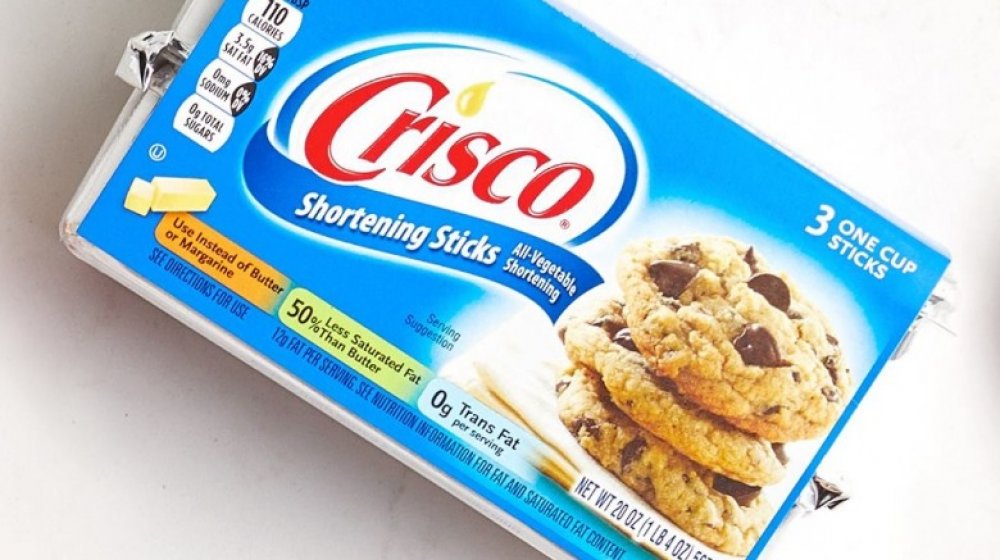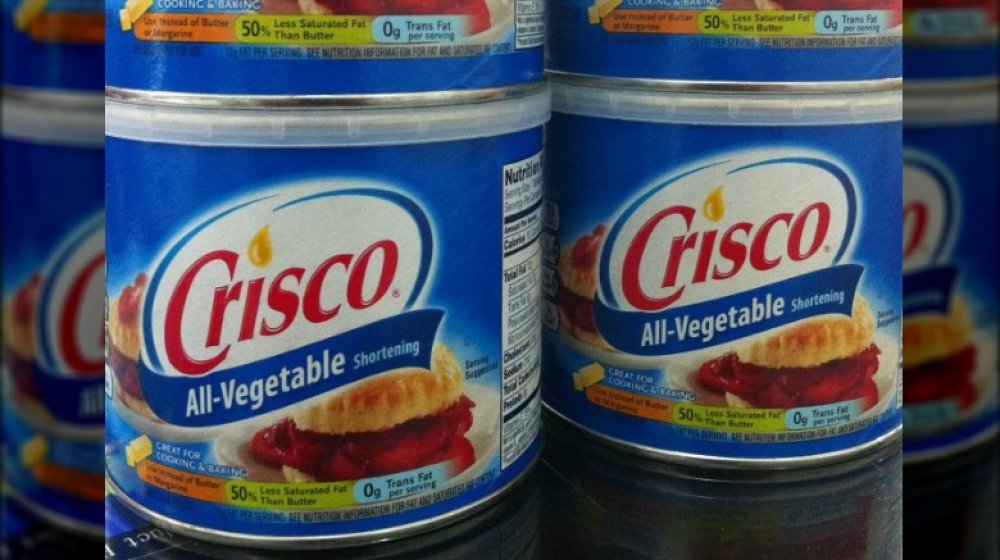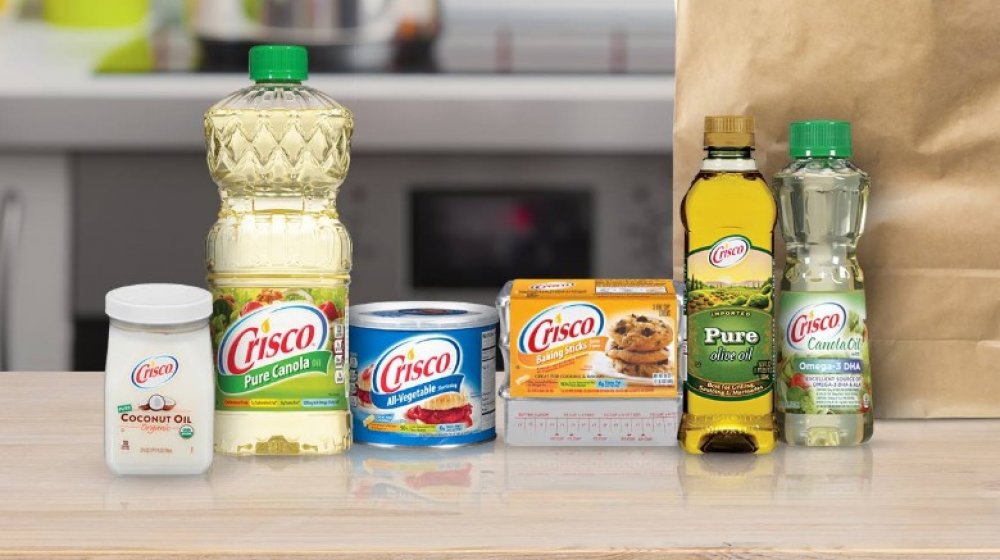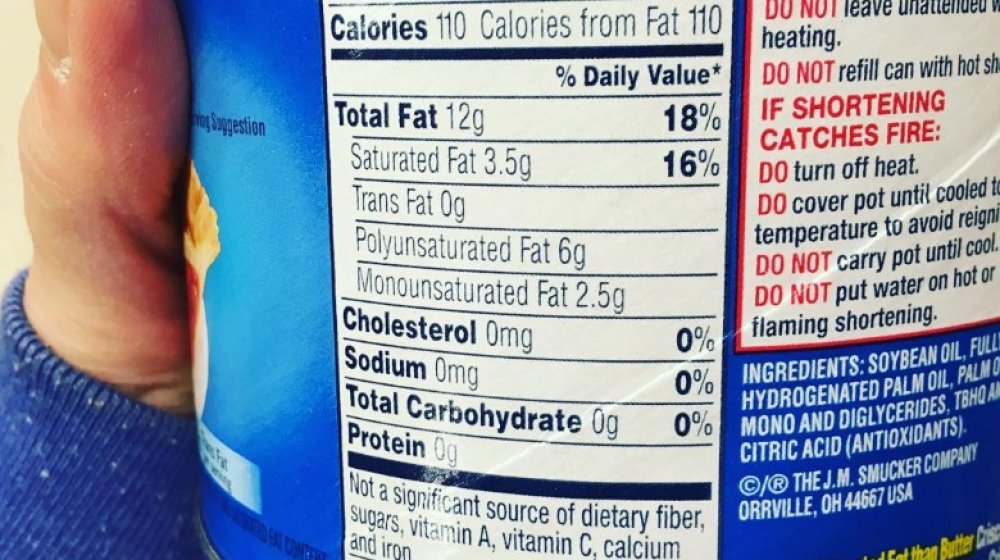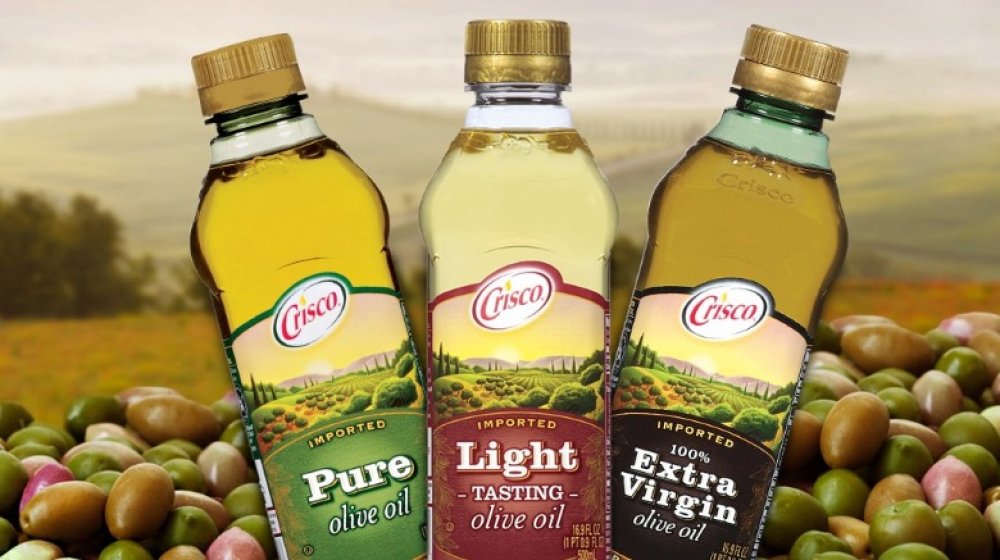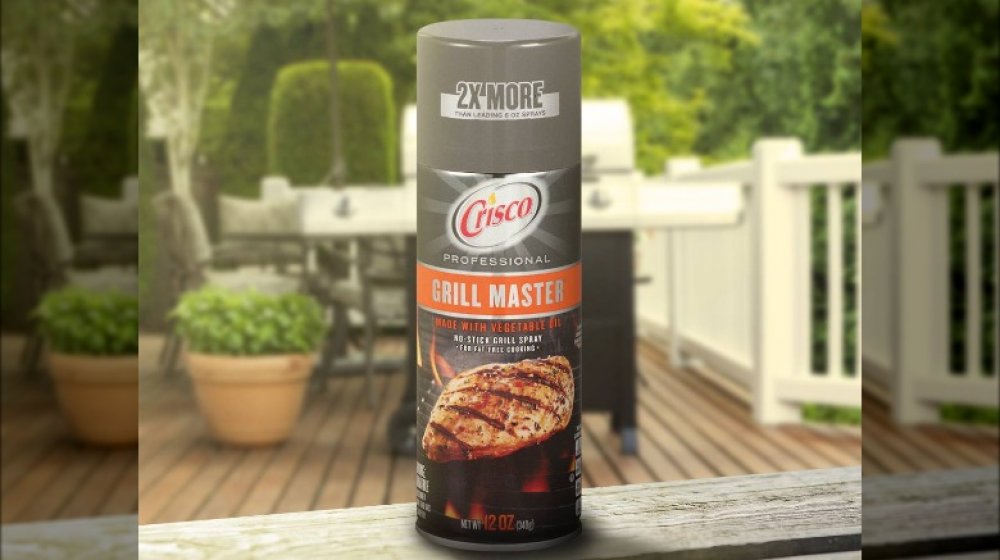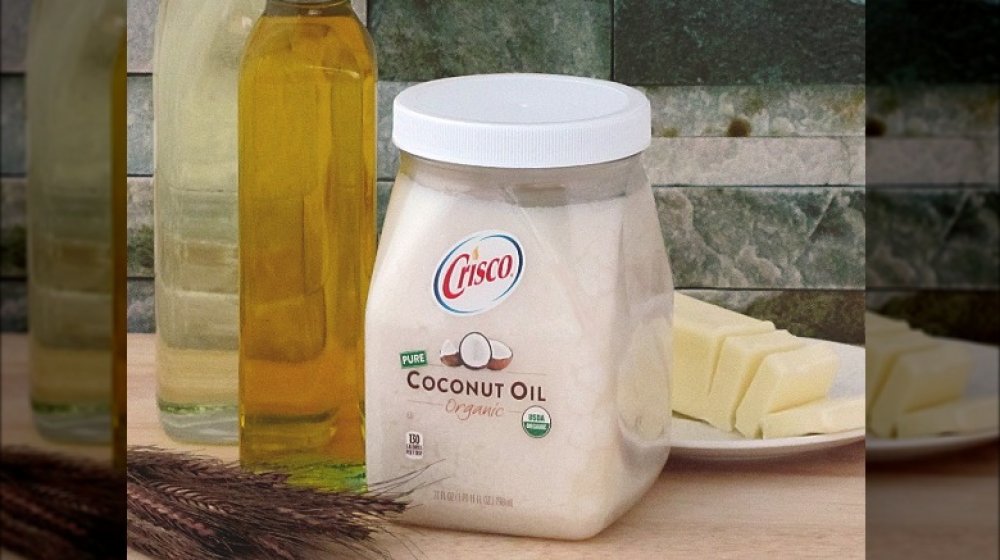This Is How Crisco Is Really Made
For diehard bakers, Crisco has long been a pantry staple — those tubs of creamy white shortening keeping their place nestled between a bag of flour and a bag of sugar. And while Crisco may not be the only vegetable shortening on the market, it's certainly the best-known, and it can claim to be the first since its introduction in 1911.
Over the years, the original vegetable shortening has changed its recipe and its packaging, and has expanded its product line to include sprays, baking sticks, and a variety of oils. The expansion of products has further solidified Crisco's placement in the market as a baker's best friend — and it's easy to see why. One quick look at the recipes created by Crisco's "Crisco Creators" on their website is enough to make your mouth water. Who wouldn't want to try sweet cherry tarts or honey cornbread muffins? But before you head to the store to stock up on all of their products, you might want to know exactly how they're made.
Crisco has been around for over 100 years
Crisco's 100-plus year history started as a story of marketing success. According to a history of the company published on Real Food Houston, Crisco was invented by Procter & Gamble and was officially introduced in 1911. William Procter and James Gamble started using hydrogenated cottonseed oil to make P&G's soap, which gave them the idea to use this artificially-solid (hydrogenated) oil product in the kitchen. And that's exactly what the original Crisco was — hydrogenated cottonseed oil.
They were able to convince customers like train lines to use it in place of lard, and they recruited doctors and rabbis for product testimonials, saying it was a healthier (and kosher!) product that could replace lard and butter in baking and frying. According to Crisco's own website, shortly after print and radio ads debuted, "products flew off of the shelves," and home cooks all over the country started using the new vegetable shortening.
Crisco is made of partially-hydrogenated vegetable oils
Butter is naturally solid at room temperature due to its saturated fats. Lard is the same, as are oils with a higher saturated fat content, like coconut oil. But other oils, like olive oil, grapeseed oil, sunflower seed oil, and soybean oil are all liquid, all the time. An article on Healthline explains that their unsaturated fats (mono- and poly-unsaturated) lack the hydrogen molecule necessary to render them solid or semi-solid at room temperature. When hydrogen molecules are added to these oils during processing, they become solid or semi-solid at room temperature, making them more spreadable, as with Crisco or margarine.
Proctor & Gamble, with the help of a chemist, came up with this hydrogenation process in the early 1900s, and according to an article written by Meghan Telpner, Crisco was the first-ever food product to include these partially-hydrogenated oils. So when the early Crisco ads touted, "the absolutely new product," they weren't lying.
But technically Crisco isn't made of vegetables
One thing to keep in mind about "vegetable oils," is that vegetables don't make oil. Think about it — have you ever heard of lettuce oil? Or cucumber oil? Of course not. As pointed out by nutritionist and founder of the Academy of Culinary Nutrition, Meghan Telpner, oils are derived from grains (like corn oil), fruits (like avocado, olive, and coconut oils), and seeds (like flaxseed oil). So why would Crisco emblazon, "vegetable oil" on the sides of their packaging?
It's not entirely clear, but it could be a sign of the times — in the early 1900s when the oil was introduced, there might have been less differentiation between types of plant-derived foods, like grains and vegetables. Think about it — many people still think of corn and avocados as vegetables, right? So it may be as simple as semantics. The other possibility is a form of marketing that Telpner refers to as "health-washing." The idea is that if you put a health claim in big, bold letters on the front of food packaging, people may be more inclined to think the product is good for them and be more inclined to buy it. So if early Crisco marketers were trying to influence people's perception of the fat as being a healthier option than butter or lard, using the words "vegetable shortening" (everyone knows vegetables are good for you, right?) on the front of the packaging was a smart call.
The original Crisco was made from partially-hydrogenated cottonseed oil
Cottonseed oil isn't commonly found on grocery store shelves, although as Healthline points out, it's often found in processed foods, like cookies, because it can extend shelf life. The article in Healthline also notes that in order to meet regulations for use as a food product, cottonseed oil has to go through refinement, bleaching, and deodorization to remove gossypol — a toxic compound. This toxic compound must be removed because it's been linked to infertility, pregnancy problems, liver damage, and respiratory distress. Unrefined cottonseed oil (the oil with gossypol) has even been used as a pesticide. In other words, it's not something you want to put in your body.
When P&G developed their hydrogenation method to start making bar soap from liquid oils rather than lard, they also decided to put it into use in the kitchen. The Weston A. Price Foundation explains that because P&G was already using cottonseed oil for its soaps (and had bought up many cotton mills in the South to manage the entire process), it made sense to continue using this form of oil. Unfortunately for everyone who jumped on the "hydrogenized oils as health products" bandwagon, time and science started to uncover a nasty truth — eating lots of hydrogenated oils isn't as good for you as Crisco (and other companies) would have you believe. In 2002, P&G sold Crisco to the J.M. Smucker Company and the formula was changed in 2007 (via Fox News).
Crisco's recipe changed due to concerns about trans fats
At just about the same time as P&G was divesting itself of its 90-year old Crisco brand, more and more evidence was building that the consumption of hydrogenated oils wasn't all that healthy. In fact, according to a 2012 NPR article on the history of Crisco, the qualities that made hydrogenation so appealing to companies and consumers — for instance, making liquid oils solid and spreadable, increasing shelf-life, and enhancing baking and frying capabilities — all depended on the creation of trans fats. Initially, these fats were thought to be more heart-healthy than saturated fats because they were a form of mono- and poly-unsaturated fats, rather than the saturated fats found (and vilified) in lard, butter, or coconut oil.
But, in the mid-1990s, studies started indicating that trans fats increased forms of artery-clogging cholesterol. An article in Healthline details that high consumption of trans fats can lead to increases in inflammation, impair blood sugar control, and harm heart health. In 2015, the U.S. Food and Drug Administration (FDA) started the process of removing artificial trans fats from processed foods. In response, Crisco changed its formula, and now the classic Crisco shortening is made of soybean oil, fully hydrogenated palm oil, and other additives. This change in the formula has enabled the Crisco brand to say that each serving of Crisco has less than zero grams of fat, although, in reality, that statement is misleading.
The current Crisco says 0-grams trans fats, but that's misleading
If numerous studies have found that trans fats are bad for heart health, and the FDA has effectively banned the addition of artificial trans fats to processed foods, and Crisco is still available for purchase at grocery stores nationwide, basic logic should determine that Crisco doesn't have trans fats, right? Especially since they put "0g trans fat per serving" right there on the can.
Oh, if only you could trust food marketers. Or the FDA. (Sorry, you can't. Not entirely.) As pointed out in an article published on NPR's website, the FDA allows foods that contain less than 0.5 grams of trans fat per serving to claim the food contains zero grams of this fat. And the FDA's own website states, "It's important to note that trans fat will not be completely gone from foods because it occurs naturally in small amounts in meat and dairy products, and is present at very low levels in other edible oils."
Okay, so if Crisco can list 0-grams trans fats on its label, and the FDA admits there's this loophole for companies to do so, even if a product has small amounts of trans fats, how can you know if Crisco has trans fats? Look to Crisco's own website at the ingredients — it's clear that Crisco still uses hydrogenated oil as an ingredient which is one of the surefire ways to know whether a product contains trace amounts of trans fats.
Crisco offers a wide range of cooking oils and sprays
One thing to keep in mind is that Crisco is a brand, not a single product. According to the Crisco website, what started out as a company featuring a single tub of vegetable shortening, slowly expanded in the 1980s and 1990s, adding easy-to-measure vegetable shortening sticks (similar to sticks of butter or margarine), followed by the addition of butter-flavored shortening.
After the sale of Crisco from P&G to the J.M. Smucker Company in 2002, even more products were added to the brand's lineup. These new additions included oils, sprays, and organic coconut oil, all designed to help Crisco hold onto its market share of baking oils, especially given the newly-unfavorable view of hydrogenated oils and trans fats for heart health that emerged in the early 2000s.
Given that Crisco isn't a single product, it's important to recognize that each product in the company's stable of oils has slightly different ingredients and is made in different ways. As of June 2020, the Crisco brand offers 18 different types of oils, differentiated as shortenings, cooking oils, no-stick cooking sprays, and coconut oils.
Their vegetable shortening is made of soybean oil, palm oil, and other additives
Crisco's line of vegetable shortening includes four total products — the original shortening, original shortening packaged as sticks, and butter-flavored shortening, as well as butter-flavored sticks. While the butter-flavored version has a slightly different list of ingredients than the original version, there are really only two different forms of shortening — original, or butter-flavored. Both versions are made from soybean oil, fully hydrogenated palm oil, palm oil, mono and diglycerides, TBHQ, and citric acid.
All-in-all, soybean oil and palm oil are types of vegetable oils that, when consumed in moderation, are unlikely to cause major harm. The catch, of course, is consuming highly processed fats, and hydrogenated fats, as this processing creates trans fats and can strip all other nutrients from these oils. Part of the reason you know these shortenings are processed is in the addition of mono- and diglycerides, which as discussed in a Healthline article, help create a better texture for margarine.
You should also be conscientious of the addition of TBHQ, or tertiary butylhydroquinone. A separate Healthline article notes that this additive helps extend shelf life, but it's highly controversial because it's been linked to health problems, like liver enlargement, increased incidence of tumors, convulsions, and paralysis in lab animals. Granted, the FDA limits how much can be used, and in the case of TBHQ, no more than 0.02 percent can be present in food. So, word to the wise, it's in Crisco.
Their oils are usually 100% oil, but some have other additives
Crisco's line of liquid oils is actually more extensive than its shortenings, including seven separate products. In general, products that are 100 percent "vegetable oil" are a better option than more processed fat products, like shortening. In the case of Crisco oils, consider the following:
- Pure Oils: Crisco's 100 percent oils include Pure Canola Oil, Pure Vegetable Oil, and Pure Corn Oil. While all of these are plant-derived fats, and most are considered good cooking oils, keep a few things in mind. First, according to an article on Healthline most inexpensive vegetable oils are derived from genetically modified plants (GMOs). Second, according to another Healthline article, because it requires a lot of processing to extract oil from these grains and seeds, they're more likely to oxidize and become unstable, or rancid. Finally, oils like corn oil are high in omega-6 fatty acids which are linked with increased inflammation.
- Frying Oils: Both Crisco's Peanut Oil and Frying Oil Blends are designed to be good for frying, but they include additives, like TBHQ, which as discussed previously may be linked to health problems.
- Canola Oil and Omega-3 DHA: Other vegetable oils get a bad wrap for an excess of omega-6 fatty acids — by adding omega-3s to its canola oil, the oil is arguably a more heart-healthy option. But a word to the wise, this oil comes with a warning: It will catch fire if overheated.
Their sprays include anti-foaming agents and propellants
Crisco offers a five-product line of cooking sprays. These sprays are highly-pressurized canisters of various types of vegetable oil that also all include:
- Soy lecithin: For most people, soy lecithin is a benign food additive used as a lubricant. In this case, to help prevent sticking. According to Healthline, it's usually added in such small amounts it's unlikely to cause problems. That said, if you have a severe soy allergen, talk to your doctor about using products that contain it.
- Dimethyl silicone: According to Chosen Foods, this anti-foaming agent may be harmless in small amounts, but it hasn't been researched extensively, and it's unclear if there could be negative health effects. One thing to keep in mind? It's also included in things like cosmetics and textile finishing products.
- Propellant: Obviously, to spray a cooking oil, you need something to encourage this release from its pressurized can. It's unclear what type of propellant Crisco uses, but according to Chosen Foods, common choices include nitrous oxide, carbon dioxide, propane, n-butane, or isobutane. So yeah, it's up to you whether you want a quick spray of propane in your foods
Cooking sprays are hyped as containing 0-grams of fat per serving, but keep in mind, a serving size is a 1/3 second spray. How often have you sprayed a cooking oil for only a 1/3 second? Probably not. Spray more, and you'll end up adding some fat to your meal.
They also offer two versions of coconut oil: refined and unrefined
Coconut oil is one of those oils that for years was vilified for being high in saturated fat content. But, as science mounted in the 2000s, indicating that plant-based saturated fats, like coconut oil, might not be as heart-unhealthy as previously thought, coconut oil made a comeback. According to Healthline, one thing that differentiates the saturated fats in coconut oil from saturated fats in animal fats (like beef and pork) is that most of these saturated fats are considered medium-chain fatty acids, rather than long-chain fatty acids.
Medium-chain fatty acids seem to boost heart health, rather than hurting it. For instance, lauric acid, which accounts for 42 percent of coconut oil, has a positive effect on increasing HDL (good) cholesterol. Stearic acid, also found in coconut oil, can help lower LDL (bad) cholesterol and doesn't appear to have a negative effect on heart health. And finally, capric acid, which is about 4 percent of coconut oil, is rapidly metabolized, has been linked to weight loss, increased insulin sensitivity, and antiseizure effects.
To be clear, more research still needs to be done. But early headlines pushing coconut oil as a heart-healthy option had companies clamoring to add coconut oil to their line of products. Crisco was no different, and now sells two types: Refined Organic and Unrefined Organic. The main difference is the refined version has been processed to eliminate the coconut flavor and smell from the oil.
